Every year, communities around the globe come together to shine a light on the experience of babies born too soon and the families who support them. World Prematurity Day invites us to reflect on the journey of preterm birth, the advances made in care, and the work still ahead so that every tiny life can begin with hope and dignity.
What is World Prematurity Day?
Picture this: a baby born at 32 weeks, or even 28 weeks, arriving into the world weeks earlier than expected. Those early days and weeks can be a whirlwind of intensive care, love, fear and hope. World Prematurity Day is a global observance dedicated to raising awareness about preterm birth — babies born before 37 weeks of pregnancy are completed — and the challenges they and their families face.
This day supports three intertwined aims: recognising the medical, social and emotional dimensions of being born too soon; advocating for quality care for small and sick newborns; and urging health systems, communities and governments to ensure equity in survival and thriving so that geography or income don’t determine a child’s chances.
When is World Prematurity Day?
The observation has traditionally been marked each year on 17 November. In 2025, however, the World Health Organization (WHO) has designated 15 November 2025 as the official date going forward, in order to dedicate a unique day free from overlap with other health observances.
The day is observed globally by hospitals, NGOs, parent groups, communities, and individuals through lighting monuments, wearing a purple ribbon (the colour of prematurity awareness), sharing stories, and organising events to bring attention to preterm birth.
Why World Prematurity Day Matters
Every baby born too soon holds potential. Yet being born preterm places infants and families at elevated risk. Globally, approximately one in ten babies is born prematurely. Without access to quality neonatal and maternal care, preterm birth can lead to life‑threatening conditions such as respiratory distress, infection, hypothermia and long‑term developmental challenges.
Importantly, survival rates and long‑term outcomes differ dramatically based on where a baby is born. In higher‑income countries, extremely preterm infants may survive with advanced care; in lower‑income settings the odds are much lower. This inequality goes to the heart of why awareness matters — supporting the idea that every baby deserves a fair start regardless of geography or wealth.
It also matters for families. Premature births bring emotional stress, disruption of expectations, potential financial burdens, and a need for specialised follow‑up care. When communities and systems support those families, the whole society benefits. The theme for 2025 — “Give preterm babies a strong start for a hopeful future” — underscores that survival alone is not enough; thriving matters too.
How to Get Involved in World Prematurity Day
You don’t have to be a specialist to take part. Whether you’re an individual, work in a school, manage a workplace, or belong to a community group — there are meaningful ways to contribute.
- Wear purple on the day (or the week) to show solidarity with preterm babies and their families. Promote the colour in your workplace, school or community space.
- Share stories and facts on social media or your networks using hashtags such as #WorldPrematurityDay, #PretermBirth and #GivePretermBabiesAStrongStart. Highlight local or personal stories of preterm births, care and hope.
- If you’re part of a health service or clinic, host a webinar, patient‑family panel or drop‑in session about preterm birth, neonatal care, or family support groups.
- For workplaces, consider hosting a “coffee & learn” session: invite a neonatal nurse or parent of a preemie to speak, or support fundraising for neonatal care equipment or parent‑support programs.
- Schools and youth groups can create artwork or awareness posters, invite guest speakers, run a “purple day” or include a lesson about birth, babies and health equity.
- Advocate in your local context: ask your local health authority how they support special care for small and sick newborns, and whether there are gaps in support for families of preterm infants. Write a letter, join a local NHS trust meeting, or volunteer with a neonatal parent organisation.
Small actions contribute to a broader movement of change — and over time those added up make a huge difference.
History of World Prematurity Day
The origins of this day lie in the work of parent‑organisations and neonatal care groups that sought to give voice to babies born too soon and their families. In 2008, the European Foundation for the Care of Newborn Infants (EFCNI) together with European parent organisations launched the first awareness activities for what would become World Prematurity Day.
By 2011 or so the day had gained global traction, as more national organisations, research bodies and parent groups joined in. Over the years, the observance has grown: lighting buildings in purple, sharing global statistics and coordinating advocacy efforts.
A landmark moment arrived in 2025 when the World Health Assembly officially added World Prematurity Day to the WHO’s international health calendar, recognising its pivotal importance for child survival and well‑being.
Noteworthy Facts About World Prematurity Day
- Globally, about 1 in 10 babies (roughly 9.9%) are born preterm (before 37 weeks) in 2020 estimates.
- Preterm birth remains the leading cause of death among children under age five.
- The 2025 campaign theme is “Give preterm babies a strong start for a hopeful future”, which emphasises not just survival but the opportunity to thrive.
- While the observance was long held on 17 November, WHO has designated 15 November 2025 as the official day going forward.
- The majority of preterm births happen in southern Asia and sub‑Saharan Africa, but they are truly a global phenomenon.
Hashtags
#WorldPrematurityDay, #PretermBirth, #GivePretermBabiesAStrongStart
Links
Related Events
November 1 - November 29
November 1 - November 29
November 1 - November 29
November 1 - November 30






